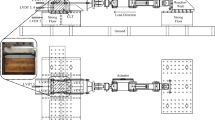Abstract
The paper presents the results of some experimental tests performed on the shear stud connection system for timber-concrete composite beams manufactured by the Tecnaria Ltd. Some push-out specimens constructed using both normal weight (NW) and light weight (LW) concrete were subjected to collapse and long-term creep tests. During the collapse test, the connector exhibited significant strength and stiffness. In the creep test performed in constant environmental conditions, delayed (creep) deformations took place mainly during the first days after loading. The next part of the creep test, conducted under cycles of environmental relative humidity, was characterized by an increase in delayed deformations (the so-called mechano-sorptive effect) due to the hygroscopic behaviour of timber around the connector. The amount of delayed deformation depended upon the cycle duration and was negligible for short period (less than one week) cycles. The use of LW concrete instead of␣NW concrete was found not to significantly affect␣the performance of the connection system␣neither in the long-term, nor in the collapse tests.
Similar content being viewed by others
References
Ceccotti A (1995) Timber-concrete composite structures. In: Blass HJ et al. (ed) Timber Engineering, Step 2, 1st edn. Centrum Hout, The Netherlands
Capozucca R (1998) Bond stress system of composite concrete-timber beams. Mater Struct 31(213):634–640
Piazza M, Ballerini M (2000) Experimental and numerical results on timber-concrete composite floors with different connection systems. In: 6th World Conference on Timber Engineering WCTE 2000, Whistler Resort, British Columbia, Canada, 31 July-3 August 2000
Gutkowksi RM, Brown K, Shigidi A, Natterer J (2004) Investigation of notched composite wood-concrete connections. J Struct Eng 130(10):1553–1561
Kenel A, Meierhofer U (1998) Holz/Beton-Verbund unter langfristiger Beanspruchung (Long term performance of timber-concrete composite structural elements), Report No. 115/39. EMPA Abteilung Holz, Dübendorf, Switzerland
Gelfi P, Giuriani E, Marini A (2002) Stud shear connection design for composite concrete slab and wood beams. J Struct Eng 128(12):1544–1550
Steinberg E, Selle R, Faust T (2003) Connectors for timber-lightweight concrete composite structures. J␣Struct Eng 129(11):1538–1545
Mascia NT, Soriano J (2004) Benefits of timber-concrete composite action in rural bridges. Mater Struct 37(266):122–128
Comité Européen de Normalisation (2003) Eurocode 5 – Design of timber structures – Part 1–1: General rules and rules for buildings, prEN 1995–1-1. Bruxelles, Belgium
Comité Européen de Normalisation (1996) Eurocode 5 – Design of timber structures –Part 2: Bridges, ENV 1995–2. Bruxelles, Belgium
Fragiacomo M, Ceccotti A (2006) Long-term behavior of timber-concrete composite beams. I: Finite element modeling and validation. J Struct Eng 132(1):13–22
Fragiacomo M (2006) Long-term behavior of timber-concrete composite beams. II: Numerical analysis and simplified evaluation. J Struct Eng 132(1):23–33
Bonamini G, Ceccotti A, Uzielli L (1990) Prove sperimentali a breve e lungo termine su elementi composti calcestruzzo - legno antico di quercia e di larice (Short- and long-term experimental tests on concrete-antique oak and larch timber composite systems). In: 8th C.T.E. Conference, Bologna, Italy
Piazza M (1990) Some notes about time-dependent deformations of connections carried out by means of glued steel bars in wooden structures. In: Communication to the RILEM T.C. 112 Meeting, London, U.K
Kuhlmann U, Michelfelder B (2004) Grooves as shear-connectors in timber-concrete composite structures. In: 8th World Conference on Timber Engineering WCTE 2004, Lahti, Finland, 14–17 June 2004
Comité Européen de Normalisation (1991) Eurocode 2 – Design of concrete structures – Part 1–1: General rules and rules for buildings, ENV 1992–1-1. Bruxelles, Belgium
Comité Européen de Normalisation (1991) Eurocode 2 – Design of concrete structures – Part 1–4: General rules – Lightweight aggregate concrete with closed structure, ENV 1992-1-4. Bruxelles, Belgium
Comité Européen de Normalisation (1998) Timber structures – Glued laminated timber – Strength classes and determination of characteristic values, prEN 1194. Bruxelles, Belgium
Comité Européen de Normalisation (1991) Timber structures – Joints made with mechanical fasteners – General principles for the determination of strength and deformation characteristics, EN 26891. Bruxelles, Belgium
Fragiacomo M, Amadio C, Macorini L (2004) Comportamento a collasso ed in esercizio di una connessione a piolo per strutture composte legno-calcestruzzo (Collapse and serviceability behaviour of a stud connector for timber-concrete composite structures). In: 15th CTE Conference, Bari, Italy, 4–6 November 2004
Ollgard JG, Slutter RG, Fischer JW (1971) Shear strength of stud connectors in lightweight and normal concrete. AISC Eng J 8:55–64
Fragiacomo M (2005) A finite element model for long-term analysis of timber-concrete composite beams. Struct Eng & Mech 20(2):173–189
Fragiacomo M, Amadio C, Macorini L (2004) A finite element model for collapse and long-term analysis of steel-concrete composite beams. J Struct Eng 130(3):489–497
Toratti T (1992) Creep of timber beams in a variable environment, Report No. 31. Laboratory of Structural Engineering and Building Physics, Helsinki University of Technology, Finland
Hanhijärvi A (2000) Advances in the knowledge of the influence of moisture changes on the long-term mechanical performance of timber structures. Mater Struct 33(225):43–49
Hanhijärvi A (2000) Computational method for predicting the long-term performance of timber beams in variable climates. Mater Struct 33(226):127–134
Fragiacomo M (2001) Comportamento a lungo termine di travi composte legno-calcestruzzo (Long-term behaviour of timber-concrete composite structures). Ph.D. Thesis, University Institute of Architecture of Venice, Italy
Acknowledgements
The technical support and financial contribution provided by the “Tecnaria Ltd.”, viale Pecori Giraldi 55, Bassano del Grappa (Vicenza), Italy, http://www.tecnaria.it is gratefully acknowledged. A special thanks to Prof. Ario Ceccotti, director of the IVALSA Trees and Timber Institute, for the useful suggestions given on the test programme and experimental set-up. The contribution made by Mr Claudio Nogarol on the conduction of some tests and data processing is also gratefully acknowledged.
Author information
Authors and Affiliations
Corresponding author
Rights and permissions
About this article
Cite this article
Fragiacomo, M., Amadio, C. & Macorini, L. Short- and long-term performance of the “Tecnaria” stud connector for timber-concrete composite beams. Mater Struct 40, 1013–1026 (2007). https://doi.org/10.1617/s11527-006-9200-2
Received:
Accepted:
Published:
Issue Date:
DOI: https://doi.org/10.1617/s11527-006-9200-2




